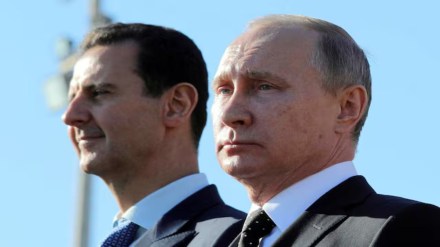The Syrian Civil War has reached a pivotal moment as President Bashar al-Assad fled to Russia after rebels seized Damascus, marking the end of his 24-year rule. This turn of events highlights the escalating rivalry between Russia and the United States, with Russia’s continued support for Assad contrasting sharply with U.S. efforts to oust him. As Assad’s regime collapses, the future of Syria remains uncertain, while the geopolitical battle between Washington and Moscow intensifies.
The Fall of Assad and His Flight to Russia
On December 9, 2024, it was confirmed that Bashar al-Assad had sought refuge in Russia after fleeing Syria amidst a rapid rebel offensive. Led by the Islamist group Hayat Tahrir al-Sham (HTS), rebels captured major Syrian cities such as Aleppo, Homs, and Hama before entering Damascus unopposed. The Assad regime crumbled as government forces retreated, leaving the president no choice but to escape.
Initial reports indicated that Assad had boarded a plane for an unknown destination, and rumours swirled about his plane being shot down by rebels. However, it was later confirmed that Assad and his family had arrived safely in Moscow, where Russia granted them political asylum. This decision reaffirmed Russia’s staunch support for Assad, a leader it has backed militarily and diplomatically throughout the civil war. Russian Ambassador to Syria Mikhail Ulyanov stated, “We do not abandon our friends in difficult times,” directly responding to US claims that Russia could not save Assad, highlighting the ideological divide between Moscow and Washington.
Russia’s Strategic Interests in Syria
Russia’s involvement in Syria has been driven by both strategic and geopolitical motives. Since 2015, Russia has played a central role in bolstering Assad’s government, sending military forces and providing logistical support to combat rebel and jihadist groups. The Russian military presence in Syria, including airbases and naval facilities in Tartus and Latakia, is key to Russia’s military strategy in the Mediterranean and broader Middle East influence.
Syria holds significant value for Russia, not only for its strategic location but also as a longtime ally. Assad’s regime has served as a counterbalance to Western influence in the region, positioning Russia as a key regional power.
Russian Foreign Minister Sergey Lavrov reiterated Moscow’s commitment to Syria’s sovereignty and territorial integrity during the 22nd Doha Forum on December 7, 2024. Lavrov condemned the use of groups like HTS for geopolitical purposes, emphasizing the importance of UN Security Council Resolution 2254, which calls for dialogue between the Syrian government and opposition. This statement reflects Russia’s continued support for Assad, despite Western-backed opposition forces.
A Stark Contrast: Russia vs. the United States
The conflict in Syria has underscored the differences between Russian and US approaches to the Middle East. For years, the US has pursued a policy of isolating Assad, supporting rebel groups, and imposing sanctions on Syria. Washington’s opposition to Assad stems from his brutal crackdown on early protests in 2011 and his alliances with Iran and Hezbollah. The U.S. has long called for regime change, viewing Assad as a destabilizing force in the region.
However, the fall of Assad’s regime suggests US efforts to oust him have largely failed. Despite years of backing opposition groups and imposing sanctions, the US was unable to prevent Assad’s eventual collapse. The decision to withdraw US forces from northern Syria in 2019 weakened America’s position and left a vacuum that Russia filled. As Ulyanov pointed out, unlike the US., Russia does not abandon its allies when they face difficulties, which has strengthened Moscow’s political influence in the region.
Life in Damascus: Looting and Destruction
With rebels taking control of Damascus, the city descended into chaos. Reports describe widespread looting, as both rebels and ordinary citizens stripped the Presidential Palace of valuables. Expensive furniture, luxury cars, and branded handbags were among the items stolen. Videos on social media showed destruction and vandalism, reflecting the deep frustration of a population worn down by years of conflict.
The looting in Damascus underscores the divisions in Syria and the economic hardships faced by its citizens. While the fall of Assad’s regime marks the end of a long era of autocratic rule, it also signals the beginning of a new period of instability. With rebels in control of the capital, Syria faces a future rife with uncertainty, as power struggles between competing factions, including jihadist groups, loom large.
What Lies Ahead for Syria and the Middle East?
Russia’s decision to grant Assad asylum is a statement of its continued dominance in the region. However, it also raises critical questions about Syria’s future. With Assad gone, Syria faces the possibility of a power vacuum that could be exploited by various factions, including foreign powers and extremist groups. Moscow has expressed its desire to facilitate dialogue between the Syrian government and opposition forces, but with Assad’s departure, the path to peace appears uncertain.
Russia’s next steps will be crucial in shaping Syria’s future. Moscow has shown interest in engaging regional powers to stabilize the country, but with the regime in disarray, it remains unclear who will lead Syria or if the country can achieve lasting peace. In the meantime, the US finds itself on the defensive, grappling with the consequences of its failed strategy in Syria. As Russia solidifies its influence, the US may need to reevaluate its policies and seek new ways to engage in a region where alliances are shifting and new geopolitical realities are taking shape.
